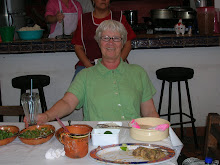I went on the Travis County Master Gardeners tour "Inside Austin" yesterday. It was one of the best I've been on (not that I've been on so many). I think the theme, sustainability, was what made it for me. The gardens were as always phenomenal, but I was really blown away by the Stocker garden. I'm not including any photos because it is really hard to do any of them justice. The best I can do is write down my impressions.
For the Stocker garden imagine a meander around the edge of a house that constantly surprises you. First the surfaces you walk on are composed of gravel and limestone slabs, so that it's a bit like stepping stones across a stream. Then when you look up you see a constantly changing view. There is no front or back of the house, there is a front door and patio seating areas but they seamlessly flow into one another. One area was mostly but not entirely home to cacti. It was a bank in bright afternoon sun backed by Junipers (or cedars for the Texans amongst you), the sun cast sharp shadows on the various shapes of the plants. There were some exquisite stacked drystone walls, done by the owners. Doors and walls divided up the spaces but never seemed too intrusive, the garden flowed in a natural way. The use of native plants was extremely effective but I was glad that the owners didn't limit themselves only to native plants. There was a beautiful blooming Mock Orange (Philadelphus virginalis 'Natchez') around one corner that was spectacular in the afternoon shade, the white flowers shining in the shadows. I also noticed a Verbena bonariensis in one bed whose leggy stems topped by a cluster of purple blooms made a sculputural feature through which to view that portion of the garden. There were too many plants to enumerate, but amongst them were Blackfoot Daisy, Winecup, Missouri Primrose, various salvias, Purple and Pink Skullcap, Purple Cone Flower, Yarrow to name just a few. What an absolutely amazing garden.
It was a unique space and you could feel the gardeners' hand on all of it. One of the reasons I like the TCMG tours is that every space is created by a gardener and that brings a richness and originality that more professionally landscaped gardens lack.
There were several gardeners who managed to grow the most interesting fruiting trees. Two gardens had olives in them and they looked beautiful with their grey foliage. The Gani's Garden had three apple trees, a fig, two peaches, a grapefruit, a grape vine, a Fuyu persimmon, blackberry, kumquat, and a loquat. All this plus vegetables, flowers and two 1500 gallon rainwater storage tanks in a small backyard, not much more than 20'X 40'. There was a small patch of lawn in the front but no grass in the back. The Stockton's had no grass, except ornamental and used hardscape for open spaces.
The Bakatsa garden had a small patch of grass in front and a backyard crammed with a huge variety of plants and a large compost pile. The fruit trees were: a huge grapefruit tree in the front yard; in the backyard three peach trees, two pomegranites (edible kind), two plums, two figs four olives and eleven citrus bushes. This plus a multitude of vegetables and flowers. If there's one thing I noticed common to all the gardens it was how close the plants were to each other. I asked each gardener how they amended their soil and while they had amended they had not:1) brought in new soil to replace existing soil, 2) brought in substantial amounts of amendments. It seemed that rarely had the amendments been more than a half inch layer on top of existing soil. They all had compost heaps which they used constantly.
Its going to take a while to absorb all this information and translate it to my own garden. But I feel much more confident about trying fruit trees in my yard. I think my main problem is going to be squirrels raiding the crops but presumably squirrels, even Rosedale squirrels, aren't big fans of olives.
Sunday, April 20, 2008
Subscribe to:
Post Comments (Atom)

No comments:
Post a Comment